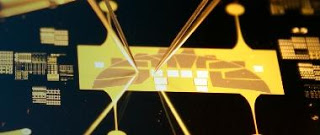Antennas that use plasma to focus beams of radio waves could bring multi-gigabit wireless networks The Wi-Gig standard is expected to go up to between 1 and 7 gigabits per second – fast enough to download a television programme in seconds. Wi-Gig requires higher radio wave frequencies : 60 gigahertz rather than the 2.4 GHz used by Wi-Fi. Plasma antennas could enable affordable Wi-gig over longer ranges to assist with lastmile issues. PSiAN could be commercially available within two years.
UK researchers are working on a solid-state plasma antenna called Plasma Silicon Antenna, or PSIAN. This uses beam forming technology and the same manufacturing process currently used for silicon chips. That makes it small enough to bung into smartphones.
PSiAN consists of thousands of diodes on a silicon chip. When activated, each diode generates a cloud of electrons – the plasma – about 0.1 millimetres across. At a high enough electron density, each cloud reflects high-frequency radio waves like a mirror. By selectively activating diodes, the shape of the reflecting area can be changed to focus and steer a beam of radio waves. This “beam-forming” capability makes the antennas crucial to ultrafast wireless applications, because they can focus a stream of high-frequency radio waves that would quickly dissipate using normal antennas.
“Beam-forming antennas are the key for enabling next-generation, high-data-rate indoor wireless applications,” says Anmol Sheth, at Intel Labs in Seattle. “Without beam-forming antennas it would be difficult to scale to the levels of density of wireless devices we expect to have in future homes.”
There are two types of plasma antenna: semiconductor or solid-state antennas, such as PSiAN, and gas antennas. Both could fit the bill, but solid-state antennas are favoured as they are more compact and have no moving parts.
Gas plasma antennas have recently been commercialized.
Gas Plasma Antenna Technology
– Operates up to 90 GHz.
– It use ionized gas as counducting material .
– The gas is ionized only for the time of transmission or reception.
-The design allows for extremely short pulses, important to many forms of digital
communication and radars.
-Predicted performance:-
Beam Positions= 16
Gain= 14dB
Switching speed= 2 micro sec
– Low weight and smaller in size
Selectabeam
* Based on Beam forming tecnology.
* Avoid the need of alignment and realignment of fixed point to point links.
* Same Benifites as that of Phased array antenna
Reflectabeam:-
* Operates upto Freqencies of 90Ghz
* Design to provide high speed selection
* At High Fequencies Applications it also include radar sensors and monitering system
PSiAn
Launched in 2010
* Based on silicon integrated circuits technology
* Its product cost does not increase with frequency
* Frequncy range -1 to 300GHz
Advantages:-
* Wide band Multimedia
* Wireless local networks
* Medical etc
Although the solid-state version is compact, it is limited to high frequencies, making certain applications tricky. For instance, indoor Wi-Gig routers operating at 60 GHz would not be able to penetrate walls. The signal would instead have to be reflected off surfaces to reach every room in a house.
Broadband wireless
Plasma Antennas’ selectable multibeam antennas enable network equipment OEMs to gain a significant competitive advantage by providing BWA systems that suppress interference and improve signal-to-interference ratios. Typically, Plasma Antennas selectable multibeam antennas are deployed at base stations or access points and communicate with fixed directional antennas at subscriber stations or other network nodes.
Mesh Networks
By integrating Plasma Antennas’ selectable multibeam antennas, mesh network equipment OEMs are able to boost the range and capacity of their systems, enabling their network operator customers to benefit from significantly lower site acquisition and rental costs, combined with a substantial reduction in overall cost per megabit of data traffic. With Plasma Antennas’ selectable multibeam antennas deployed in mesh networks, high gain beams can be aligned dynamically between nodes to provide significant improvements in the link budgets for each connection within the mesh.
Military Pain beam more compact and individual targeting
The US military is also interested in solid-state plasma antennas, for use in a more advanced version of their so-called “pain beam”, a weapon called the Active Denial System. The ADS heats a person’s skin painfully with a beam of 64 GHz radio waves. But the current design involves a 2-metre-wide, mechanically steered antenna mounted on a large truck. Switching to a small, lightweight plasma antenna would allow multiple narrow beams to selectively target several individuals at once.
Plasma antennas have a number of possible applications in the defence, space and homeland security sectors, including:
* Secure Battlefield Communications
* Low Probability of Detection Radar
* Electronic Warfare (e.g. Electronic Countermeasures ECM and Electronic Surveillance Measures ESM)
* Communications Intelligence (COMINT)
* Electronic Intelligence (ELINT)
* Border Protection & Perimeter Monitoring
* Communications with Remotely Piloted Vehicles (e.g. UAVs)
* IFF And NCTR
* Multi-purpose Common Aperture Applications
If you liked this article, please give it a quick review on ycombinator or StumbleUpon. Thanks
Featured articles
Ocean Floor Gold and Copper
Ocean Floor Mining Company

Brian Wang is a Futurist Thought Leader and a popular Science blogger with 1 million readers per month. His blog Nextbigfuture.com is ranked #1 Science News Blog. It covers many disruptive technology and trends including Space, Robotics, Artificial Intelligence, Medicine, Anti-aging Biotechnology, and Nanotechnology.
Known for identifying cutting edge technologies, he is currently a Co-Founder of a startup and fundraiser for high potential early-stage companies. He is the Head of Research for Allocations for deep technology investments and an Angel Investor at Space Angels.
A frequent speaker at corporations, he has been a TEDx speaker, a Singularity University speaker and guest at numerous interviews for radio and podcasts. He is open to public speaking and advising engagements.





